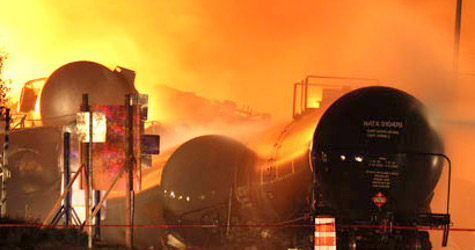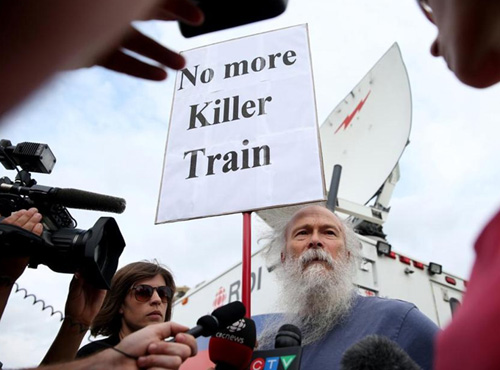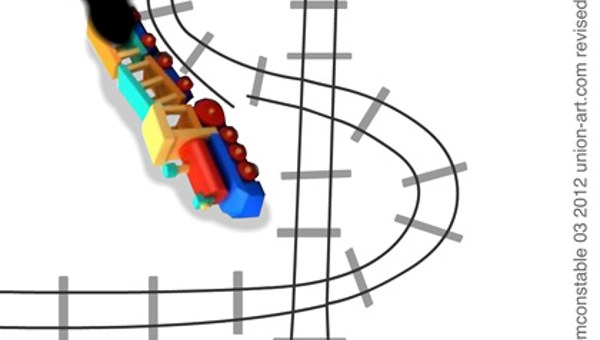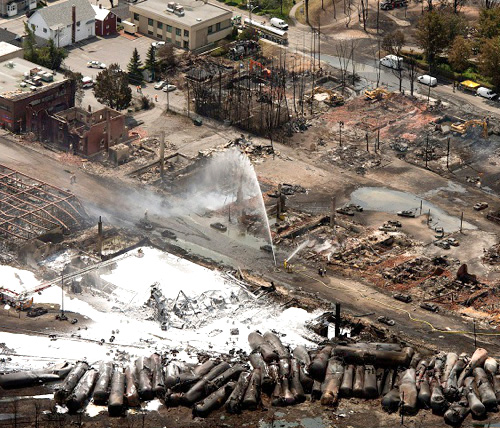The fireball in Lac-Mégantic, Quebec, flashed around the world last week as a very hot news item. Thirty-five people are now confirmed to have been killed, with 15 more still missing and presumed dead, as a result of the explosions of crude oil carried by the Montreal, Maine and Atlantic Railway’s (MM&A) runaway freight train. When Canadian prime minister Stephen Harper quickly showed up to offer his condolences, this also made international news.

Amidst all the apportioning of blame – and there is plenty enough to go around – our sober attention must also turn to what this appalling incident, like the terrible Bangladeshi textile factory fire just over a month ago, tells us about the dark side of competitive markets, and the complicity of governments committed to facilitating their spread around the world.
Market-Driven Logic
The ugly logic underlying this tragedy was starkly revealed by Ed Burkhardt, the president and CEO of the MM&A railway’s parent company, Rail World Inc, in an interview on CBC television on 9 July, the day after Harper visited the devastated town. The fundamental reason the train wasn’t being overseen on that now-infamous night, he averred, was that the 2 per cent higher labour costs entailed in hiring more workers to guard their trains would lead to a company raising their freight rates to compensate by 2 per cent, which would result in it losing the business to some other company that wasn’t paying for workers to guard their trains. However callous this sounds, he spoke nothing less than the truth when he added: “That’s the way it works.”
The “it” here is our market-driven capitalist world. As Burkhardt explained, the largest corporations in the freight train industry compete with each other by outsourcing the more accident-prone operations to smaller companies with low profit margins. And these smaller companies compete in a world where one-man train operations have become the norm in other countries. “If you go overseas, almost everybody has one-man crews,” he said. “Go to the UK, they are running 100 freight trains and 10,000 passenger trains every day with one-man crews.”
“This should once and for all be understood as an offer to carry business on the backs of governments.”
The players in this world are not only the businesses that compete in it, big and small, but also the politicians of every stripe who promise to get governments off their backs to help them do so. This should once and for all be understood as an offer to carry business on the backs of governments. They have authored the free trade agreements whose key provisions are designed to leverage the sorts of regulations that promote competitiveness from one jurisdiction to another. And they have appointed people to regulatory bodies who sustain the logic of competitiveness.
At the heart of the competitive logic behind “this is the way it works,” in this instance as in so many others, was the reduction of the number of workers to save labour costs. In the 1970s, North American freight trains usually carried five-man crews around the clock. As crew sizes shrank over the following decades, the effect of this downsizing, in turn, was to have more workers competing for jobs, which of course drives down wages – including, eventually, those of the one person left running the train.
This is not an unintended consequence of competitive markets. It is their purpose.
One can be sure that the case made to Transport Canada for permission to run a one-man crew made reference to the common use of one-man train crews in the UK. The integrated nature of global capitalism today means that so long as people in one place buy into the peddlers of the logic of competitiveness, they become inadvertently complicit in the uses made by it by the peddlers of it elsewhere. •
This article first appeared on the www.guardian.co.uk website.





